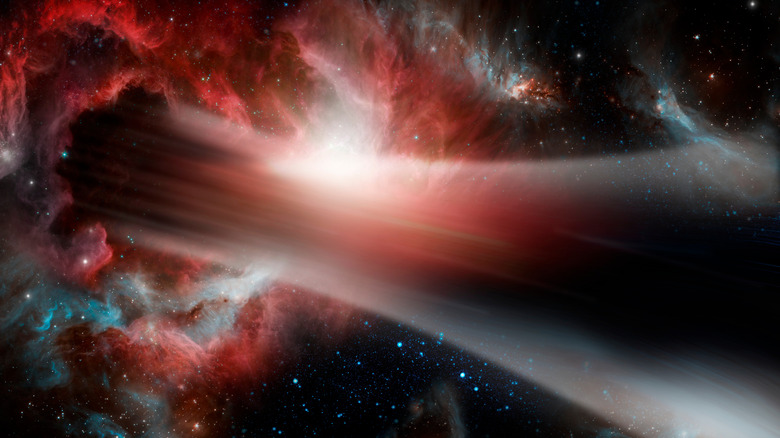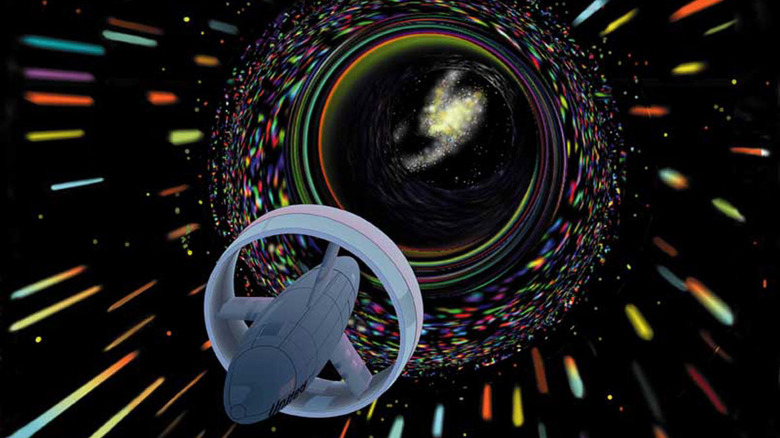Is Faster-Than-Light Travel Actually Possible?
The dream of space travel has been with humanity not only since the dawn of modern science fiction — with authors such as Robert Heinlein, Isaac Asimov, and Frank Herbert — but for literally thousands of years. The Ancient Egyptians believed their pharaohs traveled to the heavens after life and became "indestructible" stars in the sky, as The Guardian explains. Numerous Native American tribes — such as the Hopi — point to space as their origin, as outlined on Montana Pioneer. Stars, space, and the night sky aren't just subjects of fascination for astrophysicists but nigh-mystical human companions. And never mind that humans, quite literally, are made of the stuff of dead stars, as the National History Museum shows.
The desire to travel (back) to space in many ways seems as natural as breathing. Unfortunately, craft like NASA's New Horizons would take about 78,000 years to get to the nearest star system, Alpha Centauri, as EarthSky states — that's about twice as long as humans have been using language. And that craft? It travels 58,536 kilometers per hour (36,373 miles per hour). But Alpha Centauri is a mere 4.3 light-years away. The entire Milky Way Galaxy is over 100,000 light-years across, and it contains from 100 to 400 billion stars, per NASA. So the whole space travel thing? Isn't going to happen. Sorry, "Star Trek" fans. Set course, warp factor none.
Or ... is it? Crafty researchers continue to noodle away at all possibilities, and most efforts focus on one pesky problem: bypassing the impossible-to-break light-speed barrier.
Folding space like Einstein-Rosen paper
Sci-fi fans who watched 2014's "Interstellar" for the first time might have cried foul at the film's "paper and pen illustrate faster-than-light travel" scene. After all, that scene was a copy-paste job from 1997's "Event Horizon" (YouTube has a back-to-back scene comparison). In both scenes, characters use a piece of paper to demonstrate how space can be "folded" to connect two distant points. Voila: instant faster-than-light travel.
This is a simplified version of what's called an "Einstein-Rosen bridge" — a theoretical tunnel connecting two regions of spacetime. Going back to Einstein's Theory of General Relativity in 1916, subsequent work in quantum mechanics, and a heckuva lot of brain-melting math, an Einstein-Rosen bridge derives from the axiom "space tells matter how to move, and matter tells space how to curve," as the Initiative for Interstellar Studies quotes from American physicist John Wheeler.
Nothing can actually "speed up" fast enough to reach the speed of light, "c," because at that point, it would stop experiencing time. The reason being that the speed of light — 299,792,458 meters per second (983,571,056 feet) — is a mathematical constant that defines causality across all of reality, as Space describes. To light, there is no past, present, or future. Einstein-Rosen bridges bypass speed (distance over time) altogether by describing "mouths" at different points in space connected by a "throat." Mathematically, one mouth bends towards negative infinity, the other towards positive infinity, and both flatten out on either side into normal, minimally curved space. Slip through the throat? You've bypassed the light-speed barrier.
Riding a warp bubble on spacetime waves
The next candidate for faster-than-light travel is a "warp bubble," which definitely sounds like something Chief Engineer Geordi La Forge concocted to help the USS Enterprise escape a "spacetime vortex" or something on "Star Trek: TNG." Like an Einstein-Rosen bridge, a warp bubble still exists only on paper. But that paper — particularly Erik W. Lentz's recent 2021 study published in the journal "Classical and Quantum Gravity" and available on IOP Science — is pretty darn impressive.
Lentz's warp bubbles would be powered by "negative energy." This doesn't refer to negative particle charges, like an electron's, but the energy within a vacuum. As UCLA describes using a helpful, syringe-like illustration — if you pull a stopper out of a vacuum, the outward-moving force creates more vacuum inside the stopper, meaning the vacuum was full of negative energy that it already contained. This is how we can explain the inflation of space from the infinitely dense Big Bang.
As Science Alert explains, such negative energy could power an Alcubierre warp drive, named after the Mexican physicist Miguel Alcubierre in 1994 (per Phys.org). According to Lentz, a power source "30 orders of magnitude to be in range of modern nuclear fission reactors" could stretch spacetime like fabric and create a bulge, or warp bubble, on one side. Sit a ship inside the bubble, release the tension, and watch spacetime itself carry the ship like a wave. This type of wave, a soliton, could bypass the light-speed barrier.
Light-sailing starchips
At present, Einstein-Rosen bridges (wormholes) and Alcubierre warp drives (warp bubbles) are the only two leads to not only travel faster than light but carry people along for the ride. But it's critical to remember that these options don't propel an object through space faster than light — they skirt around speed restrictions altogether by warping space, as The Conversation summarizes. It's completely impossible to move through space as fast as light, let alone faster.
Even if we can't go as fast as the speed of light, though, practically anything would be better than rocket-fueled, 78,000-year-long journeys for a meager 4.3 light-years to our nearest neighbor, Alpha Centauri (as EarthSky quotes). Next best option? Another water-and-wind-inspired tech-like warp bubbles riding soliton waves: "light sailing." The idea here is that light itself, composed of particle-energy packets called "photons," could propel a spacecraft forward provided it's got big enough mirrors. This removes the need for fuel, which is the heaviest part of a spacecraft, and less mass requires less energy to move.
As Scientific American continues, this solution doesn't include human passengers. Rather, it uses microchip-sized "starchips" buoyed by super-thin, reflective sails that catch photons. These starchips could potentially travel at 20% light speed, which doesn't cover a lot of ground compared to "Star Trek's" warp drive, but could still arrive at Alpha Centauri within 20 years. At the very least, such probes could help carry the dream of faster-than-light travel and space exploration.



